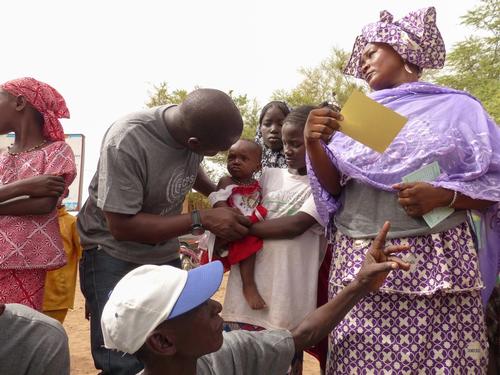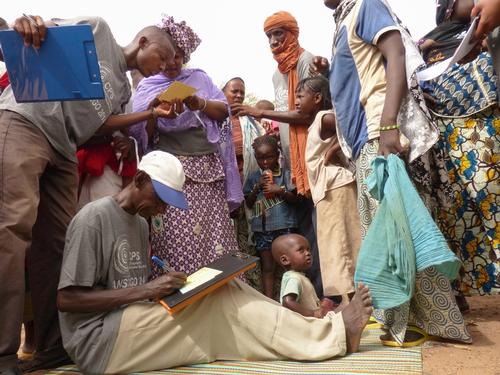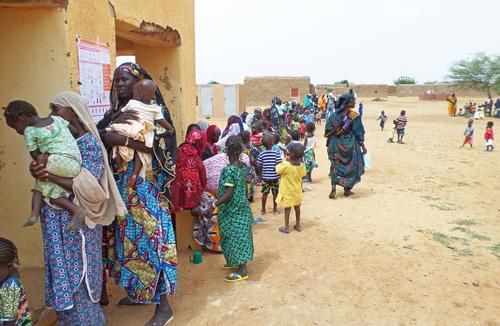José Bafoa landed in Mali scarcely a month ago and immediately began to work with the MSF team in Ansongo (a district of the Gao region in the north of the country) to prepare the seasonal malaria chemoprevention (SMC): a preventive strategy that consists of administering an antimalarial treatment to children under five years of age for three days per month during the period of highest transmission of the disease.
This is not the first time that Dr Bafoa has managed an SMC: last year he supervised an SMC implementation in two districts of Niger, where more than 61,000 children received treatment. Nor is it the first time he has worked in Mali: he was in Gao from September 2012 to the beginning of 2013, a few months after conflict broke out between the security forces and Tuareg and Islamist groups, and when the military offensive by France, Chad and Mali to retake control of the area was unfolding. The current situation is calmer, but it continues to be unstable, with occasional incidents in the area.
Implementing the SMC
“The first round of SMC in Ansongo took place at the beginning of August and succeeded in reaching more than 28,000 children; 1,000 more than predicted. In this area, the epidemiological data shows a drastic increase in cases of malaria between August and October. This is the period of highest transmission, which coincides with the rainy season. Therefore, during these three months, we will provide antimalarial treatment to children between three months and five years old, once per month, to prevent the disease.
SMC is being carried out in 16 health areas; there are 30 mobile teams that go to the most remote populations and 16 fixed teams located at the health centres. The teams administer the first two pills of the treatment in situ and give the mothers the other two pills that the child must take the following two days. In addition, the nutritional condition of the children is examined. In total, more than 300 people are working on this activity. All of them have been trained in advance and have done simulations in various places.”

First experience of SMC in northern Mali
“In general, northern Mali is a very overlooked area, with little NGO presence. We are among the few to have been present before, during and after the crisis. It is an unstable context, with armed groups in five of the sixteen health areas where the SMC campaign is being organised. Unfortunately, much of the civilian population has been caught between the different interests of the belligerent groups.
This has led to limitations on the movement of NGOs and an increase in the health needs of the people, who have to overcome financial and geographical barriers in order to obtain healthcare. Women give birth in their homes and many die from haemorrhages; there is no drinkable water in some areas; harvests are not sufficient to meet all the needs.
There is also the particular epidemiological profile, with many cases of severe malaria (with anaemia or neuronal malaria). But children in the north have the right to be protected and treated each year against the most deadly childhood disease. Malaria is the main cause of hospitalisation and mortality for children under five years of age in the north.”
Teamwork to carry out SMC
“We have adapted SMC to the limitations on movement that exist in Ansongo. The strategy has been implemented by the staff of the Ministry of Health, but with the technical support of MSF, and a shared effort with other organisations in the area.
In this way, MSF has taken charge of all the technical, financial and logistical elements. For its part, the Ministry of Health has implemented the strategy with its staff, the heads of the health centres, the managers of the health programme of the district, and the community health workers. The organisation Première Urgence has been responsible for awareness-raising and has pre-positioned materials at certain distribution points. Also, Action Against Hunger has taken responsibility for children with malnutrition detected during the campaign.

Good population response
“The figures speak for themselves. According to the population data we have, the coverage of the first round of SMC has been 105%.
You have to see it for yourself. The mothers come with their children in carts pulled by donkeys after travelling five to seven kilometres, to get the SMC medication. Villages where SMC has not been organised have sent representatives to negotiate for the campaign to also be held in their settlements. There is a great enthusiasm on the part of the parents. Both the health authorities and the traditional authorities have greatly supported us with social mobilisation and awareness-raising. This is the secret: involving the population and the local authorities in everything that we do, and having good coordination and organisation.”
Desired results: to reduce malaria cases
“First of all, with the SMC we want to reduce the number of cases of malaria, and above all the number of serious cases. It is also an opportunity to help sick children who have not had access to healthcare, such as children with malnutrition.
But we also know that, thanks to the SMC, we get the chance to strengthen the technical capacities of the district's health personnel, since they are the people who have carried out the strategy and now know how to implement it. In addition, it is useful for us to work together with other organisations in the area, thereby joining forces to reduce infant morbidity and mortality.”
MSF has been working in Ansongo since September 2012
“Currently, we are working at the Ansongo reference hospital, providing free healthcare to the whole population in the external consultancy and hospitalisation services, in maternity, where we have surgical capacity for obstetric emergencies, and in the laboratory. We also ensure referrals from health clinics to the city of Ansongo, and from Ansongo to the Gao hospital. Furthermore, we provide epidemiological monitoring for the area and are ready to respond to emergencies, such as population displacements, outbreaks of measles, meningitis and cholera, among others, or injured people. On top of all that, we are now involved in the SMC.”




